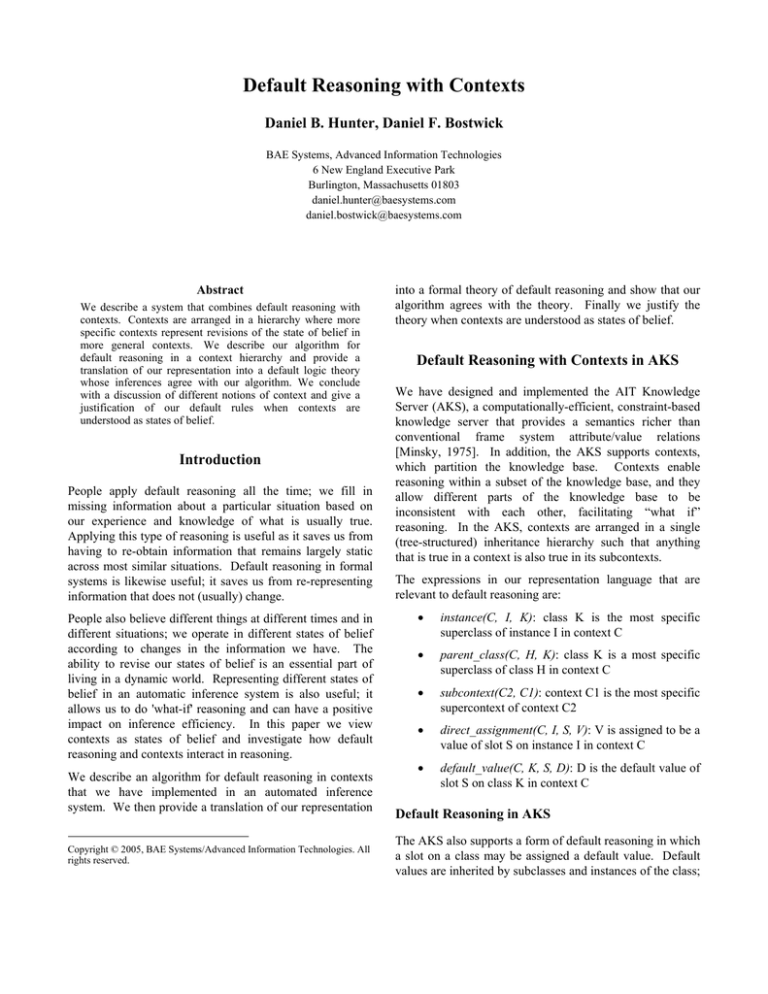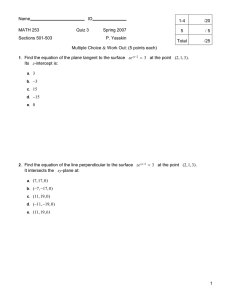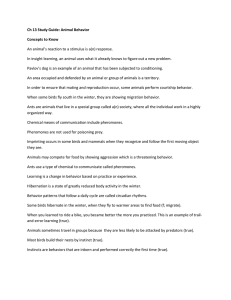
Default Reasoning with Contexts
Daniel B. Hunter, Daniel F. Bostwick
BAE Systems, Advanced Information Technologies
6 New England Executive Park
Burlington, Massachusetts 01803
daniel.hunter@baesystems.com
daniel.bostwick@baesystems.com
Abstract
We describe a system that combines default reasoning with
contexts. Contexts are arranged in a hierarchy where more
specific contexts represent revisions of the state of belief in
more general contexts. We describe our algorithm for
default reasoning in a context hierarchy and provide a
translation of our representation into a default logic theory
whose inferences agree with our algorithm. We conclude
with a discussion of different notions of context and give a
justification of our default rules when contexts are
understood as states of belief.
Introduction
People apply default reasoning all the time; we fill in
missing information about a particular situation based on
our experience and knowledge of what is usually true.
Applying this type of reasoning is useful as it saves us from
having to re-obtain information that remains largely static
across most similar situations. Default reasoning in formal
systems is likewise useful; it saves us from re-representing
information that does not (usually) change.
People also believe different things at different times and in
different situations; we operate in different states of belief
according to changes in the information we have. The
ability to revise our states of belief is an essential part of
living in a dynamic world. Representing different states of
belief in an automatic inference system is also useful; it
allows us to do 'what-if' reasoning and can have a positive
impact on inference efficiency. In this paper we view
contexts as states of belief and investigate how default
reasoning and contexts interact in reasoning.
We describe an algorithm for default reasoning in contexts
that we have implemented in an automated inference
system. We then provide a translation of our representation
Copyright © 2005, BAE Systems/Advanced Information Technologies. All
rights reserved.
into a formal theory of default reasoning and show that our
algorithm agrees with the theory. Finally we justify the
theory when contexts are understood as states of belief.
Default Reasoning with Contexts in AKS
We have designed and implemented the AIT Knowledge
Server (AKS), a computationally-efficient, constraint-based
knowledge server that provides a semantics richer than
conventional frame system attribute/value relations
[Minsky, 1975]. In addition, the AKS supports contexts,
which partition the knowledge base. Contexts enable
reasoning within a subset of the knowledge base, and they
allow different parts of the knowledge base to be
inconsistent with each other, facilitating “what if”
reasoning. In the AKS, contexts are arranged in a single
(tree-structured) inheritance hierarchy such that anything
that is true in a context is also true in its subcontexts.
The expressions in our representation language that are
relevant to default reasoning are:
•
instance(C, I, K): class K is the most specific
superclass of instance I in context C
•
parent_class(C, H, K): class K is a most specific
superclass of class H in context C
•
subcontext(C2, C1): context C1 is the most specific
supercontext of context C2
•
direct_assignment(C, I, S, V): V is assigned to be a
value of slot S on instance I in context C
•
default_value(C, K, S, D): D is the default value of
slot S on class K in context C
Default Reasoning in AKS
The AKS also supports a form of default reasoning in which
a slot on a class may be assigned a default value. Default
values are inherited by subclasses and instances of the class;
these default values can be overridden by subclasses and
instances. In the event that an instance does not specify a
value for a slot, then the inherited default value for the slot,
if specified, becomes the value of the instance’s slot. Slots
are not required to have any value assigned to them.
The value for a slot on an instance can either be assigned
directly or inherited from a default value in a superclass. If
slot S on instance I (notated as I.S) has no directly assigned
value, we search upwards in the class hierarchy for a most
specific superclass of I that has a default value for S. With
contexts, the reasoning becomes more complicated.
Consider Figure 1 where we have two contexts:
1.
a context called birds in which we are agnostic as
to whether or not birds can fly, but we know that
penguins, in general, cannot
2.
a subcontext called birds_can_fly in which we
have modified our belief to be that birds, in
general, can fly
Context birds
Context birds_can_fly: birds
Class bird
slot: can_fly
Class penguin : bird
slot: can_fly = false
Class bird
slot: can_fly = true
Instance george : penguin
Figure 1. Class hierarchy over two contexts
The question is whether or not george can fly in the context
birds_can_fly. Given a context C, an instance I of class K
(where K is a most specific superclass of I), and a slot S on
I, we use the following algorithm to determine the value of
I.S in C. We use a special symbol no_value_found to
indicate that no value has been assigned to I.S in C.
The function value_of(C, I, S ) returns a value for slot S on
instance I in context C. value_of first looks for a value that
is directly assigned to I.S in C or any supercontexts of C.
Failing that, value_of looks for a default value on slot S in
the superclass of I in context C.
value_of(C, I, S ):
V = direct(C, I, S)
if V == no_value_found
return default(C, K, S)
else
return V
direct(C, I, S) returns a value that is directly assigned to slot
S on instance I in context C or any ancestor contexts of C.
direct( C, I, S ) :
if direct_assignment(C, I, S,V ) then
return V
else
if subcontext( C, Cp )
return direct(Cp, I, S )
else
return no_value_found
The function default(C, K, S) returns a default value for slot
S on class K in context C. The context hierarchy is
searched before the class hierarchy. All ancestor contexts
of C are searched for a default value on K.S before any
superclasses of K are searched.
default(C, K, S ) :
V = default_for_class(C, K, S )
if V != no_value_found
return V
else
for each Kp where parent_class(C, K, Kp )
V = default(C, Kp, S )
If V != no_value_found
return V
return no_value_found
The function default_for_class(C, K, S) returns a default
value for slot S on class K in context C. default_for_class
does not examine any superclasses of K; it searches only in
context C and its supercontexts for a default value on K.S.
default_for_class(C, K, S ) :
if default_value(C, K, S, V )
return V
else
if subcontext( C, Cp )
return default_for_class(Cp, K, S)
else
return no_value_found
For the situation illustrated in Figure 1 this algorithm gives
the result:
value_of( birds_can_fly, george, can_fly ) = false
Justification of Default Reasoning Mechanism
[Etherington, 1988] provides a translation of a class
inheritance hierarchy with exceptions into a set of default
rules in Reiter’s system of default logic. A similar
translation can be given for our system of default reasoning.
In Reiter’s system of default logic [Reiter, 1980], a default
theory is a pair ∆ = <D, W>, where W is a set of first-order
formulas and D is a set of rules of the form:
α (x ): β (x )
χ (x)
where α ( x ), χ ( x ) , and β (x ) are first-order formulas
whose free variables are among x .
ii. If direct_assignment(C′, I, S, V) ∈ Σ, where C′ is a
supercontext of C and I is an instance of K, then
x = I is an exception.
W is the set of facts and D provides a means of drawing
tentative conclusions. The intuitive meaning of the above
default rule is that if α (a ) is known and it is consistent to
believe β (a ) , then χ (a ) may be inferred. ( a is a
sequence of individual constants replacing the variables x .)
A more formal interpretation of a default theory is provided
by the notion of an extension. An extension of a default
theory <D, W> is a set E of formulas that is a minimal fixed
point1 of an operator Γ on sets of formulas satisfying:
1.
W ⊆ Γ(S)
2.
Γ(S) is closed under logical consequence
3.
Given α ( x ) : β ( x ) / χ ( x ) ∈ D, if α (a ) ∈
Γ(S) and ¬β (a ) ∉ S , then χ (a ) ∈ Γ(S)
An extension for a default theory is often regarded as a set
of propositions constituting an “acceptable” set of beliefs
given the theory.
A default rule with β (x ) = χ (x ) is said to be normal;
one with β (x ) = χ ( x ) ∧ ϕ ( x ) for some ϕ (x ) is seminormal. Our translation will always result in either normal
or semi-normal default rules.
If Σ is a set of AKS assertions describing an inheritance
hierarchy with contexts, we give a translation of Σ into a
default theory <D(Σ), W(Σ)> as follows:
iii. If default_assignment(C′, H, S, D′) ∈ Σ, where C′
is a subcontext of C and H is K or a subclass of K,
then C′∧H(x) is an exception.
iv. If default_assignment(C′, H, S, D′) ∈ Σ, where C′
is a supercontext of C and H is a subclass of K,
then H(x) is an exception.
Given this translation, the algorithm for default reasoning
described in the previous section can be shown to agree
with the conclusions derivable from <D(Σ), W(Σ)>. More
precisely, we have the following theorem:
Theorem 1. If AKS infers conclusion P from default theory
<D(Σ), W(Σ)>, then P is in an extension of <D(Σ), W(Σ)>2.
What Contexts Represent
Applying the translation to the example in the previous
section yields the following default theory:
W = { birds_can_fly → birds, birds_can_fly → penguin(george) }
D = { birds∧penguin(X) : can_fly(X,false)/can_fly(X,false),
birds_can_fly∧bird(X) : can_fly(X,true) ∧¬penguin(X)/
can_fly(X,true) }
It is straightforward to show that can_fly(george,false) is
derivable from birds_can_fly.
1.
If instance(C, I, A) ∈ Σ, then C → A(I) ∈ W(Σ)
2.
If parent_class(C, B, A) ∈ Σ, then (x)(C∧B(x) →
A(x)) ∈ W(Σ)
subclass
3.
If subcontext(C2, C1) ∈ Σ, then C2 → C1 ∈ W(Σ)
bird-in-C
4.
If direct_assignment(C,I,S,V) ∈
Σ, then the
default C : S ( I ,V ) ∧ ¬C1 ∧ … ¬Ck / S ( I ,V ) ∈
D(Σ), where the Ci are nearest subcontexts of C
such that direct_assignment(Ci, I, S, V′) ∈ Σ for
some V′ (i.e. there is no context between C and Ci
in which a direct assignment to S for I is made).
5.
If default_value(C, K, S, D) ∈ Σ,
then
C ∧ K ( x) : S ( x, D) ∧ ¬E1 ∧ …¬Ek / S ( x, D)
∈ D(Σ), where the Ei are all the exceptions
(defined below) to default_value(C, K, S, D).
The exceptions to default_value(C, K, S, D) are the following:
i.
If direct_assignment(C′, I, S, V) ∈ Σ, where C′ is
C or a subcontext of C and I is an instance of K,
then (C ′ ∧ x = I ) is an exception.
isa
X is a fixed point of an operator O if O(X) = X.
subclass
penguin
george
isa
Figure 2. Avian inheritance hierarchy.
As the above default theory shows, we regard penguins as
exceptions to birds flying even in subcontexts of the context
in which penguins are declared not to fly by default; yet we
don’t regard birds in the context birds_can_fly as special
kinds of birds whose default properties can override those
of other subclasses of bird. This introduces an asymmetry in
the treatment of subclasses and subcontexts. We might
have regarded contexts as defining special subclasses of the
classes defined within them, in which case we could
2
1
bird
For reasons of space, proofs could not be included in this
paper. They are available upon request from the authors.
represent the entire class/context hierarchy in the previous
section in terms of a single class hierarchy with no explicit
contexts as shown in Figure 2. The context information is
embedded in a special subclass of bird, the class bird-in-C
(where C stands for a subcontext of the context birds).
If the default flying status for a bird-in-C is that it flies, then,
we cannot arrive at a clear conclusion about George’s flying
ability. (This example is isomorphic to the notorious
“Nixon diamond” [Touretzky, 1984].)
We wish to argue that whether or not any inference can be
made about George’s flying abilities given the above default
rules depends upon how contexts are interpreted. [Akman
and Surav, 1996] surveys the multifarious ways in which
the notion of context has been understood. Some think of
contexts as being the same or similar to situations as
understood, say, in situation theory [Barwise and Perry,
1983]. A situation is regarded as a collection of states of
affairs, where states of affairs might be thought of as
possible facts. An actual situation might even be identified
with a particular spatio-temporal slice of the universe.
If contexts are thought of as situations, then it does make
sense to regard the restriction of a class to those instances
occurring in a particular context as a subclass of that class1.
For on this construal of contexts, C2 is a subcontext of C1 if
C2 is a restriction of C1 to some particular subset of the
facts occurring in C1. Thus the set of instances of a class K
that occur in context C2 will be a subset, and often a proper
subset, of the set of instances of K occurring in C1. For
example, if by default penguins don’t fly and one considers,
say, birds-inhabiting-Patagonia, which do fly by default,
there’s no reason to simply assume that penguinsinhabiting-Patagonia don’t fly.
(Perhaps unusual
gravitational conditions in Patagonia give all birds the
ability to fly.)
Another interpretation of “context” is as a state of belief.
On this interpretation a subcontext represents an extension
of its parent’s state of belief. Thus a subcontext represents
a state of belief in which all of the beliefs in the parent are
still held plus other beliefs that are added in the subcontext
(provided the new beliefs are consistent with the old ones).
is inherited by birds_can_fly. The default inference rules for
AKS class/context hierarchies can therefore be justified
when contexts are understood as belief states2.
Conclusion
We have described an implementation of a default
reasoning system that combines class inheritance
hierarchies with contexts. A translation of assertions in our
system into default rules in Reiter's system of default logic
was given. These default rules can be justified when the
notion of a context is understood as a state of belief and a
subcontext as an extension or revision of a state of belief.
References
Akman, V. and Surav, M.
1996.
“Steps Toward
Formalizing Context,” in AI Magazine 17(3), pp. 55-72,
Barwise, J. and Perry, J. 1983. Situations and Attitudes.
Cambridge:MIT Press.
Etherington, D. W., 1988. Reasoning with Incomplete
Information. Los Altos: Morgan Kaufmann Publishers.
Minsky, M. 1975. “A framework for representing
knowledge” in P. Winston ed., The Psychology of Computer
Vision. New York: McGraw-Hill, pp. 211-280.
Reiter, R. 1980. “A logic for default reasoning” in
Artificial Intelligence 13, North-Holland, pp. 81-132.
Shore, J. “Relative Entropy, Probabilistic Inference, and
AI.” In Proceedings of the First Conference on Uncertainty
in Artificial Intelligence, ed. L. Kanal and J. Lemmer,
Elsevier Science Publishing Co., Inc., 1985.
Touretzky, D. S., 1984. “Implicit ordering of defaults in
inheritance systems.” In Proceedings of the Fifth National
Conference on Artificial Intelligence, pp. 322-325.
Acknowledgement
On this interpretation of what a context is, defaults holding
in supercontexts are inherited by a context unless
overridden. Hence the context birds_can_fly simply adds to
the information present in its parent context birds, the
information that by default birds can fly. This default rule
is consistent with the information contained in birds that by
default penguins cannot fly and so that piece of information
This material is based upon work supported by the Air
Force Research Laboratory under Contract No. F30602-01C-0041. Any opinions, findings and conclusions or
recommendations expressed in this material are those of the
authors and do not necessarily reflect the views of the
United States Air Force.
1
2
In Cyc, for example, it is assumed that quantifiers in
rules for a given microtheory range only over objects
existing in the situation described by the microtheory.
A more formal argument for this conclusion can be given,
using maximum relative entropy updating for belief revision
and a probabilistic/statistical model of default rules.


